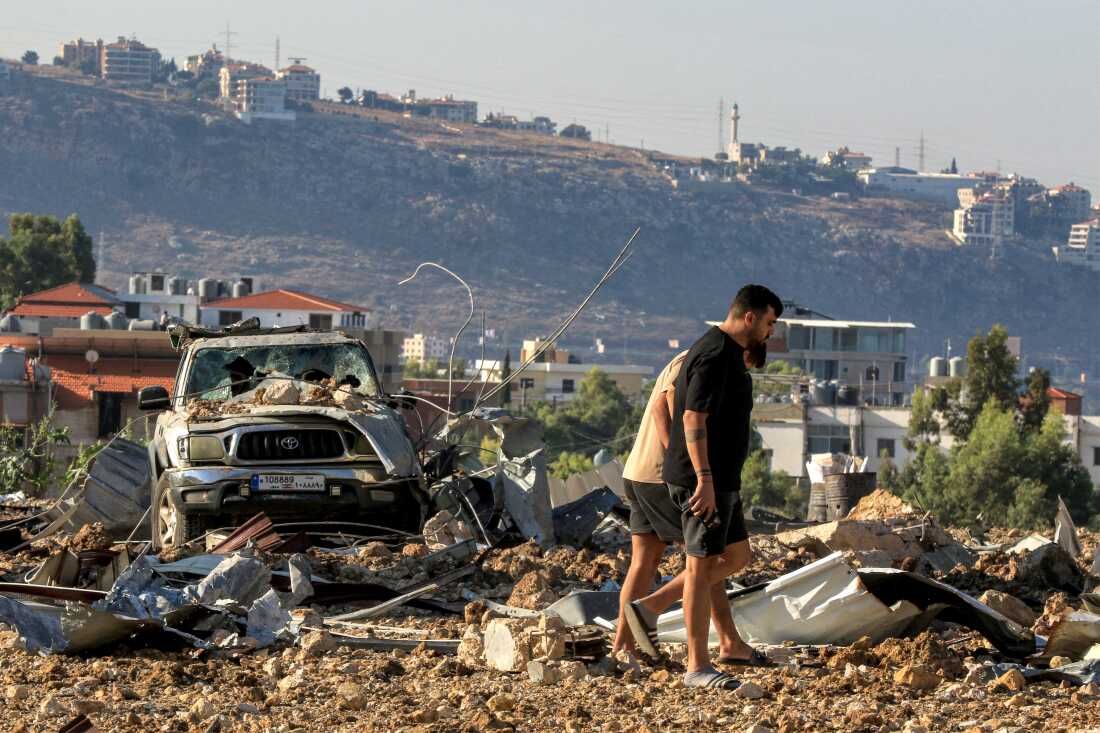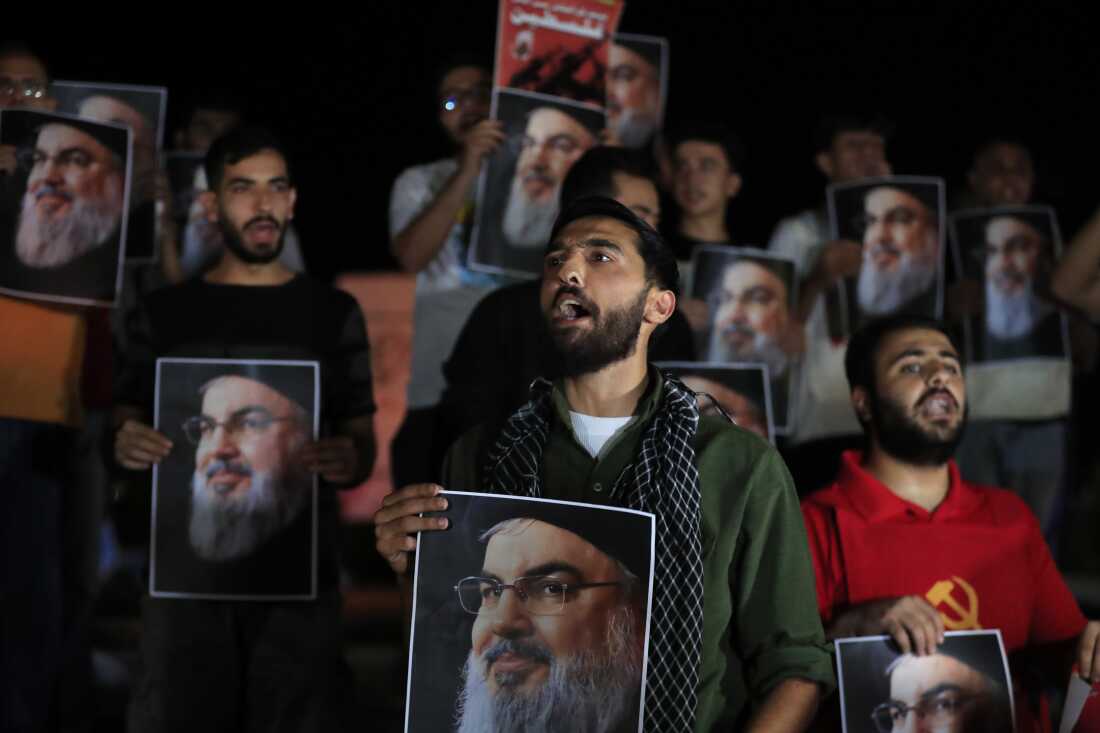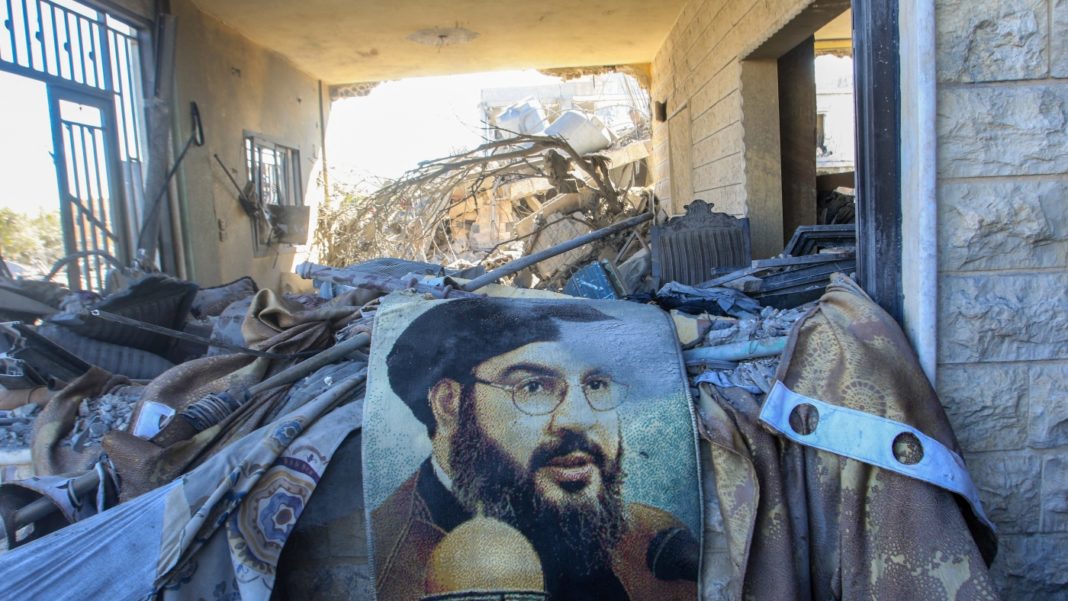A portrait of Hezbollah chief Hassan Nasrallah sits amid destruction in an area targeted overnight by Israeli airstrikes in Saksakiyeh on Sept. 26.
Mahmous Zayyat/AFP via Getty Images
hide caption
toggle caption
Mahmous Zayyat/AFP via Getty Images
Israel announced on Saturday that it had killed Hassan Nasrallah, the longtime leader of Hezbollah, in a powerful series of airstrikes that rocked Beirut on Friday evening. The Iranian-backed militia later confirmed Nasrallah’s death.
The announcement came after an eventful and deadly 12 days in the fighting between Israel and Hezbollah — including the killing of several other high-ranking Hezbollah officials and more than 1,000 people in Lebanon after a series of near-synchronized explosions followed by thousands of Israeli airstrikes over several days. These attacks left thousands more wounded and displaced tens of thousands of people.

Hezbollah also retaliated against Israel, firing hundreds of rockets toward northern Israel, and at least one long-range cruise missile toward Tel Aviv, which was intercepted by Israel’s air defense system. It was the first time the militant group had ever done so. Although most of these projectiles were shot down, several did make it through, causing damage to residential homes, a regional hospital and injuring several civilians.
Here’s a more detailed timeline of how these dramatic events unfolded:
Sept. 17: Thousands of pagers — many belonging to Hezbollah members — simultaneously explode across Lebanon and Syria, killing at least 13 people, including some children, and injuring around 4,000, hundreds of them critically. Israel is widely believed to be behind the attack, but does not publicly take credit for it. Earlier in the day, Israel had announced a new goal in the war: to return tens of thousands of displaced Israelis who had been driven from their homes near the border with Lebanon by almost a year of Hezbollah rocket fire, signaling it might take further military action against Hezbollah.

A funeral ceremony is held on Sept. 18 in the Dahiyeh neighborhood, south of the capital Beirut, for four people who were killed in Lebanon when pagers used by Hezbollah members detonated.
Houssam Shbaro/Anadolu via Getty Images
hide caption
toggle caption
Houssam Shbaro/Anadolu via Getty Images
Sept. 18: A fresh wave of explosions of communications devices, including walkie-talkies, strikes Lebanon, killing 14 and wounding some 450, according to Lebanese health officials. Israeli Defense Minister Yoav Gallant speaks about “excellent achievements” by Israel’s military and intelligence branches leading to “impressive results,” but does not mention the device attacks of the previous two days.

A man reacts on while holding a Hezbollah flag during the funeral on Sept. 18 in Beirut for people killed after pagers exploded in a deadly wave across Lebanon the previous day.
Anwar Amro/AFP via Getty Images
hide caption
toggle caption
Anwar Amro/AFP via Getty Images
Sept. 19: Israel says it struck hundreds of rocket launchers in southern Lebanon, putting them out of commission.
Sept. 20: Israel strikes a residential building in a crowded Beirut suburb during rush hour, later announcing it has killed Ibrahim Akil, Hezbollah’s military commander. Thirty-seven people were killed in the strike, including entire families, and dozens were wounded. Hezbollah later confirmed Akil’s death, along with 15 other Hezbollah members. Akil had been wanted by the U.S. for involvement in a deadly attack on the U.S. Embassy in Beirut in 1983, according to the State Department. The Israeli military said Akil was planning an attack on northern Israel, similar to the Hamas-led attack last Oct. 7 that sparked the war in Gaza.
Sept. 21: The Israeli Air Force strikes approximately 400 Hezbollah targets in Lebanon, including rocket launchers and additional military infrastructure in southern Lebanon, saying that the launchers were aimed at Israel. Lebanon’s interior minister, Bassam Mawlawi, says its intelligence agencies are working to dismantle a spy network, saying that Lebanon is in a “delicate and dangerous” security climate.

Rescuers sift through the rubble at the scene of an Israeli strike that targeted Beirut’s southern suburbs a day earlier, as search and rescue operations continue on Sept. 21.
AFP/via Getty Images
hide caption
toggle caption
AFP/via Getty Images
Sept. 22: Hezbollah and Israel trade heavy fire overnight and into the early morning hours. In southern Lebanon, residents described huge explosions that lit up the night sky. The Israeli military said it hit some 290 targets, including Hezbollah rocket launchers, while some of Hezbollah’s rockets hit deeper into Israel than they have previously in this war.
Sept. 23: Israel calls on residents of southern Lebanon to leave only hours before blanketing the area with more than 1,300 airstrikes. Those strikes kill at least 558 people, including women, children and health care workers, and injure more than 1,800, according to Lebanon’s ministry of health. This is the highest single-day death toll in Lebanon in decades. On the same day, Hezbollah fires around 200 rockets at northern Israel, most of which were intercepted by Israel’s aerial defense system. In the evening, Israel strikes an apartment in Beirut where Ali Karaki, Hezbollah’s southern front commander and third in the organization’s hierarchy, was staying. He survives.
Sirens sound in the northern Israeli city of Haifa and nearby towns. Israel said Haifa was targeted for the first time since the war began nearly a year ago.

Smoke billows from a site targeted by Israeli shelling in the southern Lebanese village of Zaita on Sept. 23. The Israeli military on Sept. 23 told people in Lebanon to move away from Hezbollah targets and vowed to carry out more “extensive and precise” strikes against the Iran-backed group.
Mahmoud Zayyat/AFP via Getty Images
hide caption
toggle caption
Mahmoud Zayyat/AFP via Getty Images
Sept. 24: Hezbollah and Israel continue to trade fire through the night. Israel issues more warnings to residents in southern Lebanon to flee, while heavily bombarding the area with hundreds of additional airstrikes, killing dozens more — including two U.N. workers — and wounding many others. Iran’s president warns in an interview with CNN that Lebanon must not become “another Gaza at the hands of Israel.” Israel says a strike in Beirut killed the head of Hezbollah’s missile division, Ibrahim Kobeissi.
Sept. 25: Early in the morning, Hezbollah launches a long-range missile that reaches Tel Aviv airspace before being shot down by Israeli forces — the first time the militant group has launched a missile like this toward central Israel. Israel continued its airstrike campaign across much of southern Lebanon, killing at least another 72 people and injuring about 400, according to Lebanese health officials. The Israeli military also announces it is calling up two additional brigades of reserves for the north, saying that it must “prepare very strongly” for a ground invasion into southern Lebanon.

People inspect the site of an Israeli airstrike in Jiyeh along the highway linking Beirut to the southern city of Sidon on Sept. 25. In south Lebanon, a stronghold of Hezbollah, Israeli warplanes bombed villages for a third day on Sept. 25, after airstrikes earlier in the week killed at least 558 people in the deadliest day of violence since the 1975-1990 civil war.
Mahmoud Zayyat/AFP via Getty Images
hide caption
toggle caption
Mahmoud Zayyat/AFP via Getty Images
Sept. 26: Amidst the backdrop of the United Nations General Assembly in New York, the U.S. and France, backed by other members of the G-7, propose a 21-day cease-fire plan between Israel and Lebanon. Israeli officials, including Prime Minister Benjamin Netanyahu, are quick to reject it.
Hezbollah fires dozens of rockets toward northern Israel, most of which were intercepted, while Israel says it carried out more than 200 airstrikes in Lebanon, killing another 92 people and wounding more than 150, according to Lebanese health officials. This brings the total number of people killed in Lebanon by Israeli airstrikes during the week to more than 700. Tens of thousands of Lebanese are displaced while fleeing Israel’s constant bombardment. Lebanese officials say it is the country’s largest displacement in decades.
Later, Israel says it has killed Hezbollah’s air force commander, Mohammed Hussein Sarour, in a strike in southern Beirut.
Sept. 27: In a fiery speech at the United Nations General Assembly in New York, Netanyahu says Israel is “winning” on multiple fronts and would attack Iran and its proxies anywhere in the Middle East. Many of the delegates in the U.N. hall leave in a public snub at the start of his address — in which he calls the U.N. a “swamp of antisemitic bile.”

Israeli Prime Minister Benjamin Netanyahu addresses world leaders during the United Nations General Assembly on Sept. 27 in New York City.
Spencer Platt/Getty Images
hide caption
toggle caption
Spencer Platt/Getty Images
Shortly after Netanyahu finishes speaking, several Israeli airstrikes rock southern Beirut in a series of blasts that can be felt around the city. The strikes demolished multiple residential buildings in southern Beirut, which Israeli officials almost immediately label the headquarters of Hezbollah, even as the smoke and debris clouds from the explosion rose above the city.
Sept. 28: Several hours later, the Israeli military announces that Hezbollah leader Hassan Nasrallah was killed in the strike in Beirut. Hezbollah later confirms his death. Analysts say the killing of Nasrallah has transformed an already complex and deadly regional conflict, with a broad array of potential outcomes for Israel, Gaza, Lebanon and beyond.

Lebanese and Palestinian men hold portraits of Hezbollah leader Hassan Nasrallah during a protest in the southern port city of Sidon, Lebanon, on Sept. 28.
Mohammed Zaatari/AP
hide caption
toggle caption
Mohammed Zaatari/AP


